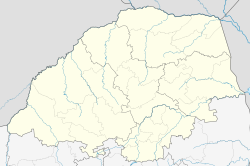Modjadjiskloof
Modjadjiskloof
Duiwelskloof | |
|---|---|
 Modjadjiskloof | |
| Coordinates: 23°42′S 30°08′E / 23.700°S 30.133°ECoordinates: 23°42′S 30°08′E / 23.700°S 30.133°E | |
| Country | South Africa |
| Province | Limpopo |
| District | Mopani |
| Municipality | Greater Letaba |
| Area | |
| • Total | 2.99 km2 (1.15 sq mi) |
| Elevation | 875 m (2,871 ft) |
| Population (2011)[1] | |
| • Total | 1,815 |
| • Density | 610/km2 (1,600/sq mi) |
| Racial makeup (2011) | |
| • Black African | 47.4% |
| • Coloured | 0.5% |
| • Indian/Asian | 2.8% |
| • White | 47.9% |
| • Other | 1.5% |
| First languages (2011) | |
| • Afrikaans | 43.7% |
| • Northern Sotho | 23.3% |
| • English | 12.3% |
| • Tsonga | 9.7% |
| • Other | 11.0% |
| Time zone | UTC+2 (SAST) |
| Postal code (street) | 0835 |
| PO box | 0835 |
| Area code | 015 |
Modjadjiskloof, also known by its former name Duiwelskloof (Afrikaans for Devil's Gorge) [Also spelled as Duivelskloof] is a small town situated at the foot of the escarpment in the Limpopo province of South Africa.
The village is 18 km north of Tzaneen. Surveyed in 1919 and proclaimed in 1920, it was administered by a village management board. The name, Afrikaans for ‘Devil’s ravine’, was possibly given by virtue of the rugged, awe inspiring aspect, or because of the difficulty with which laden wagons trekked through it in the rainy season. The railway station was called Modjadji in 1914 but was later renamed.[2] The Sunland Baobab tree, that was located nearby, lost a large chunk of its main stem early in 2017 and the rest of the tree fell into pieces in April 2017.
Name change[]
Duiwelskloof was renamed Modjadjiskloof on June 14, 2004 in honour of the Modjadji or Rain Queen, hereditary ruler of the Balobedu people of the area and the only ruling queen in South Africa.
References[]
- ^ Jump up to: a b c d "Main Place Modjadjiskloof". Census 2011.
- ^ "Dictionary of Southern African Place Names (Public Domain)". Human Science Research Council. p. 144.
- Populated places in the Greater Letaba Local Municipality
- 1920 establishments in South Africa
- Limpopo geography stubs


